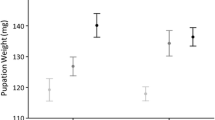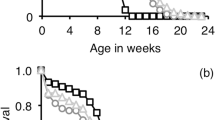Summary
In many insects nutrients transferred by the male at mating are later incorporated into both the eggs and soma of the mated females. Accordingly, it has been suggested that insect females can use these male-derived nutrients for somatic maintenance and enhancement of their fecundity and fitness of their offspring. I this paper we tested the validity of these predictions by studying the longevity and reproductive output of 1, 2, 3, 4 or 5 times mated female monarchs Danaus plexippus, a nectar-feeding butterfly that is long-lived and strongly polyandrous and emerges as an adult without mature eggs. Females mated five times received ejaculates that corresponded to an average of 38% of their body weight at eclosion. However, we found that the number of times females had mated had no effect on their longevity, life-time fecundity, or egg weight. Although negative evidence should always be interpreted with caution, our study suggests that male-derived nutrients are less important for female longevity and reproductive output than are larval and adult food.
Similar content being viewed by others

References
Barker JF, Herman WS (1976) Effect of photoperiod and temperature on reproduction of the monarch butterfly Danaus plexippus. J Insect Physiol 22:1565–1568
Boggs CL (1981a) Selection pressures affecting male nutrient investment at mating in Heliconiine butterflies. Evolution 35:931–940
Boggs CL (1981b) Nutritional and life-history determinants of resource allocation in holometabolus insects. Am Nat 117:692–709
Boggs CL, Gilbert LE (1979) Male contribution to egg production in butterflies: evidence for transfer of nutrients at mating. Science 206:83–84
Boggs CL, Watt WB (1981) Population structure of pierid butterflies. IV. Genetic and physiological investment in offspring by male Colias. Oecologia 50:320–324
Bowen BJ, Codd CG, Gwynne DT (1984) The katydid spermatophore (Orthoptera: Tettigonidae): Male nutritional investment and its fate in the mated female. Aust J Zool 32:23–31
Butlin RK, Woodhatch CW, Hewitt GM (1987) Male spermatophore investment increases female fecundity in a grasshopper. Evolution 41:221–225
Dixon CA, Erickson JM, Kellet DN, Rothschild M (1978) Some adaptations between Danaus plexippus and its food plant, with notes on Danaus chrysippus and Eploea core (Insecta: Lepidoptera). J Zool 185:437–467
Drummond BC (1984) Multiple mating and sperm competition in the Lepidoptera. In: Smith RL (ed) Sperm competition and the evolution of animal mating systems. Academic Press, New York
Dunlap-Pianka HL (1979) Ovarian dynamics in Heliconius butterflies: correlations among daily oviposition rates, egg weights, and quantitative aspects of oogenesis. J Insect Physiol 25:741–749
Dunlap-Pianka HL, Boggs CL, Gilbert LE (1977) Ovarian dynamics in Heliconiine butterflies: Programmed senescence versus eternal youth. Science 197:487–490
Friedel T, Gillott C (1977) Contribution of male-produce proteins to vitellogenesis in Melanoplus sanguipes. J Insect Physiol 23:145–151
Gilbert LE (1976) Postmating female odor in Heliconius butterflies: a male-contributed antiaphrodisiac. Science 193:419–420
Greenfield MD (1982) The question of paternal investment in Lepidoptera: male-contributed proteins in Plodia interpunctella. Int J Invert Reproduc 5:323–330
Gwynne DT (1984a) Male mating effort, confidence of paternity, and insect sperm competition. In: Smith RL (ed) Sperm competition and the evolution of animal mating systems. Academic Press, New York
Gwynne DT (1984b) Courtship feeding increases female reproductive success in bushcrickets. Nature 307:361–363
Gwynne DT, Bowen BJ, Codd CG (1984) The function of the katydid spermatophore and its role in fecundity and insemination (Orthoptera: Tettigonidae). Aust J Zool 32:15–22
Jones KN, Odendaal FJ, Erlich PR (1986) Evidence against the spermatophore as paternal investment in the checkerspot butterflies (Euphydryas: Nymphalidae). am Midl Nat 116:1–6
Labine PA (1968) The population biology of the butterfly Euphydryas editha. VIII. Oviposition and its relation to patterns of oviposition in other butterflies. Evolution 22:799–805
Munger F, Harriss TT (1969) Laboratory production of the monarch butterfly Danaus plexippus. J Res Lepid 8:169–176
Pliske TE (1973) Factors determining mating frequencies in some New World butterflies and skippers. Ann Ent Soc Amer 66:164–169
Pliske TE (1975) Courtship behaviour of the monarch butterfly, Danaus plexippus. Ann Ent Soc Amer 68:143–151
Rothschild M (1978) Hell's angels. Anternna 2:38–39
Rutowski RL (1984) Sexual selection and the evolution of butterfly mating behavior. J Res Lepid 23:125–142
Rutowski RL, Newton M, Schaefer J (1983) Interspecific variation in the size of the nutrient investment made by male butterflies during copulation. Evolution 37:708–713
Rutowski RL, Gilchrist GW, Terkanian B (1987) Female butterflies mated with recently mated males show reduced reproductive output. Behav Ecol Sociobiol 20:319–322
Simmons LW (1988) The contribution of multiple mating and spermatophore consumption to the lifetime reproductive success of female field crickets (Gryllus bimaculatus). Ecol Entomol (in press)
Sugawara Y (1979) Mating frequency in females of the small cabbage white, Pieris rapae crucivora Boisduval (Lepidoptera: Pieridae). Kontyu 47:335–339
Svärd L (1985) Paternal investment in a monandrous butterfly, Pararge aegeria. Oikos 45:66–70
Svärd L, Wiklund C (1988) Prolonged mating in the monarch butterfly Danaus plexippus, and nightfall as a cue for sperm transfer. Oikos 51:351–354
Thornhill R, Alcock J (1983) The evolution of insect mating systems. Harvard University Press, Cambridge
Urquhart FA (1960) The monarch butterfly. University of Toronto Press, Toronto
Walker WF (1980) Sperm utilization strategies in nonsocial insects. Am Nat 115:780–799
Wiklund C, Forsberg J (1985) Courtship and male discrimination between virgin and mated females in the Orange Tip butterfly Anthocharis cardamines. Anim Behav 34:328–332
Zalucki MP (1981) The effect of age and weather on egg laying in Danaus plexippus L. (Lepidoptera: Danaidae). Res Popul Ecol 23:318–327
Author information
Authors and Affiliations
Rights and permissions
About this article
Cite this article
Svärd, L., Wiklund, C. Fecundity, egg weight and longevity in relation to multiple matings in females of the monarch butterfly. Behav Ecol Sociobiol 23, 39–43 (1988). https://doi.org/10.1007/BF00303056
Received:
Accepted:
Issue Date:
DOI: https://doi.org/10.1007/BF00303056



